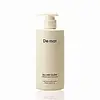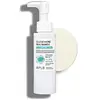What's inside
What's inside
 Key Ingredients
Key Ingredients

 Benefits
Benefits

 Concerns
Concerns

 Ingredients Side-by-side
Ingredients Side-by-side

Water
Skin ConditioningHelianthus Annuus Seed Oil
EmollientButylene Glycol
HumectantSimmondsia Chinensis Seed Oil
EmollientDipropylene Glycol
HumectantGlycerin
Humectant1,2-Hexanediol
Skin ConditioningGlyceryl Stearate
EmollientCetearyl Stearate
Skin ConditioningCetearyl Olivate
Sorbitan Olivate
EmulsifyingCeramide NP
Skin ConditioningCentella Asiatica Extract
CleansingPropolis Extract
Skin ConditioningAsiaticoside
AntioxidantMadecassoside
AntioxidantMadecassic Acid
Skin ConditioningAsiatic Acid
Skin ConditioningAllantoin
Skin ConditioningPanthenol
Skin ConditioningPropanediol
SolventArachidyl Alcohol
EmollientDecyl Glucoside
CleansingBehenyl Alcohol
EmollientArachidyl Glucoside
EmulsifyingCarbomer
Emulsion StabilisingCaprylyl Glycol
EmollientArginine
MaskingEthylhexylglycerin
Skin ConditioningAlcohol Denat.
AntimicrobialSodium Carbonate
BufferingCitric Acid
BufferingDipotassium Glycyrrhizate
HumectantWater, Helianthus Annuus Seed Oil, Butylene Glycol, Simmondsia Chinensis Seed Oil, Dipropylene Glycol, Glycerin, 1,2-Hexanediol, Glyceryl Stearate, Cetearyl Stearate, Cetearyl Olivate, Sorbitan Olivate, Ceramide NP, Centella Asiatica Extract, Propolis Extract, Asiaticoside, Madecassoside, Madecassic Acid, Asiatic Acid, Allantoin, Panthenol, Propanediol, Arachidyl Alcohol, Decyl Glucoside, Behenyl Alcohol, Arachidyl Glucoside, Carbomer, Caprylyl Glycol, Arginine, Ethylhexylglycerin, Alcohol Denat., Sodium Carbonate, Citric Acid, Dipotassium Glycyrrhizate
Glycine Soja Oil
EmollientSorbeth-30 Tetraoleate
EmulsifyingMentha Arvensis Leaf Oil
MaskingMelaleuca Alternifolia Leaf Oil
AntioxidantTocopheryl Acetate
AntioxidantHelianthus Annuus Seed Oil
EmollientOlea Europaea Fruit Oil
MaskingSimmondsia Chinensis Seed Oil
EmollientOenothera Biennis Oil
EmollientGlutathione
Niacinamide
SmoothingWater
Skin ConditioningLimonene
PerfumingGlycerin
HumectantDipropylene Glycol
Humectant1,2-Hexanediol
Skin ConditioningButylene Glycol
HumectantSqualane
EmollientAsiaticoside
AntioxidantMadecassic Acid
Skin ConditioningAsiatic Acid
Skin ConditioningHippophae Rhamnoides Fruit Extract
Skin ConditioningHydrolyzed Collagen
EmollientBeta-Glucan
Skin ConditioningArtemisia Annua Extract
MaskingOryza Sativa Extract
AbsorbentNelumbo Nucifera Extract
Skin ConditioningSaccharomyces Ferment
Skin ConditioningSolanum Melongena Fruit Extract
Skin ConditioningMelaleuca Alternifolia Leaf Extract
PerfumingGlycine Soja Oil, Sorbeth-30 Tetraoleate, Mentha Arvensis Leaf Oil, Melaleuca Alternifolia Leaf Oil, Tocopheryl Acetate, Helianthus Annuus Seed Oil, Olea Europaea Fruit Oil, Simmondsia Chinensis Seed Oil, Oenothera Biennis Oil, Glutathione, Niacinamide, Water, Limonene, Glycerin, Dipropylene Glycol, 1,2-Hexanediol, Butylene Glycol, Squalane, Asiaticoside, Madecassic Acid, Asiatic Acid, Hippophae Rhamnoides Fruit Extract, Hydrolyzed Collagen, Beta-Glucan, Artemisia Annua Extract, Oryza Sativa Extract, Nelumbo Nucifera Extract, Saccharomyces Ferment, Solanum Melongena Fruit Extract, Melaleuca Alternifolia Leaf Extract
 Reviews
Reviews

Ingredients Explained
These ingredients are found in both products.
Ingredients higher up in an ingredient list are typically present in a larger amount.
1,2-Hexanediol is a synthetic liquid and another multi-functional powerhouse.
It is a:
- Humectant, drawing moisture into the skin
- Emollient, helping to soften skin
- Solvent, dispersing and stabilizing formulas
- Preservative booster, enhancing the antimicrobial activity of other preservatives
Asiatic Acid is a major component of Centella Asiatica Extract. It has wound-healing, anti-inflammatory, and antioxidant properties.
Studies show Asiatic Acid is able to block the pathway for skin inflammation receptors, helping to soothe skin.
As an antioxidant, asiatic acid helps protect our skin against damaging environmental factors.
Learn more about Asiatic AcidAsiaticoside comes from the super popular skin-soothing ingredient, Centella asiatica. It is one of four active compounds found in the extract of Centella Asiatica.
Asiaticoside is an antioxidant and helps with wound healing. It has been shown to increase antioxidant activity during the wound healing process.
Butylene Glycol (or BG) is used within cosmetic products for a few different reasons:
Overall, Butylene Glycol is a safe and well-rounded ingredient that works well with other ingredients.
Though this ingredient works well with most skin types, some people with sensitive skin may experience a reaction such as allergic rashes, closed comedones, or itchiness.
Learn more about Butylene GlycolDipropylene Glycol is a synthetically created humectant, stabilizer, and solvent.
This ingredient helps:
Dipropylene glycol is technically an alcohol, but it belongs to the glycol family (often considered part of the ‘good’ alcohols). This means it is hydrating and gentle on skin unlike drying solvent alcohols like denatured alcohol.
As a masking agent, Dipropylene Glycol can be used to cover the smell of other ingredients. However, it does not have a scent.
Studies show Dipropylene Glycol is considered safe to use in skincare.
Learn more about Dipropylene GlycolGlycerin is already naturally found in your skin. It helps moisturize and protect your skin.
A study from 2016 found glycerin to be more effective as a humectant than AHAs and hyaluronic acid.
As a humectant, it helps the skin stay hydrated by pulling moisture to your skin. The low molecular weight of glycerin allows it to pull moisture into the deeper layers of your skin.
Hydrated skin improves your skin barrier; Your skin barrier helps protect against irritants and bacteria.
Glycerin has also been found to have antimicrobial and antiviral properties. Due to these properties, glycerin is often used in wound and burn treatments.
In cosmetics, glycerin is usually derived from plants such as soybean or palm. However, it can also be sourced from animals, such as tallow or animal fat.
This ingredient is organic, colorless, odorless, and non-toxic.
Glycerin is the name for this ingredient in American English. British English uses Glycerol/Glycerine.
Learn more about GlycerinHelianthus Annuus Seed Oil is the oil derived from the seeds of a Sunflower. Sunflower seed oil is non-fragrant. It is an emollient, meaning it helps to soften the skin.
Sunflower seed oil contains many fatty acids. The fatty acids found in sunflower seeds include (from highest amount to least): linoleic acid, myristic acid, palmitic acid, stearic acid, arachidic acid, oleic acid, and linolenic acid.
These fatty acids help the skin create ceramides. Ceramides play a role in repairing the skin barrier.
Helianthus Annuus Seed Oil helps moisturize the skin. This in turn helps the skin look more rejuvenated and smoother.
Sunflowers are rich in vitamin E.
Historians believe Indigenous cultures of North America domesticated sunflowers before corn. Thus they relied on sunflower oil for a variety of uses. One such use is moisturizing skin and hair.
Sunflower seed oil may not be fungal acne safe. We recommend speaking with a professional if you have any concerns.
Learn more about Helianthus Annuus Seed OilMadecassic Acid is a major component of Centella Asiatica Extract. It has anti-inflammatory and antioxidant properties.
It is a triterpenoid, meaning it naturally acts as an antioxidant. Antioxidants protect your skin against damage from environmental factors such as pollution and UV.
Studies show Madecassic Acid helps soothe the skin due to its ability to block inflammation pathways.
Learn more about Madecassic AcidThis oil comes from the seeds of the desert shrub called Jojoba. It is more commonly known as jojoba oil, a non-comedogenic oil.
Jojoba oil does not contain fragrance and has many fatty-acids, making it a great soothing ingredient.
It also contains Vitamin E, a great moisturizing ingredient. Vitamin E is also an antioxidant and protects your skin against oxidative damage.
This ingredient humectant properties, meaning it helps draw moisture from the air. This helps keep your skin hydrated.
While jojoba has antibacterial properties, it is only able to kill some strains of bacteria.
Studies also show it helps in wound healing. In fact, Indigenous cultures have used jojoba as a moisturizer and to help treat burns for centuries.
Fun fact: Jojoba oil similar to natural human skin sebum, so it has a great effect on dry skin. It is also promising with helping to regulate sebum production.
Due to its fatty acid content, Jojoba oil may not be fungal acne safe. We recommend speaking with a professional if you have any concerns.
Learn more about Simmondsia Chinensis Seed OilWater. It's the most common cosmetic ingredient of all. You'll usually see it at the top of ingredient lists, meaning that it makes up the largest part of the product.
So why is it so popular? Water most often acts as a solvent - this means that it helps dissolve other ingredients into the formulation.
You'll also recognize water as that liquid we all need to stay alive. If you see this, drink a glass of water. Stay hydrated!
Learn more about Water